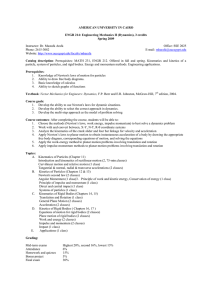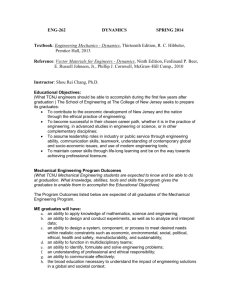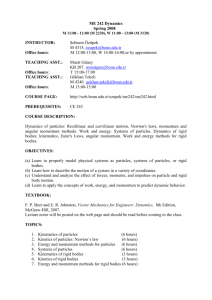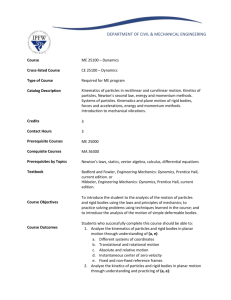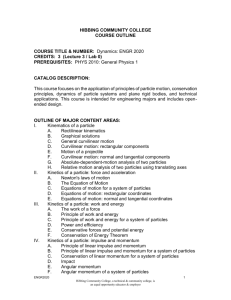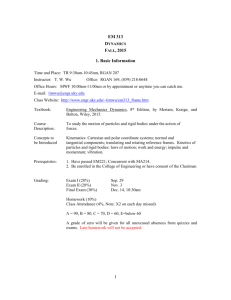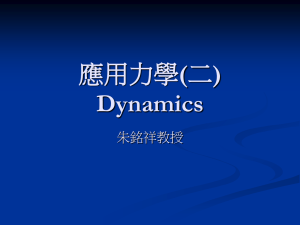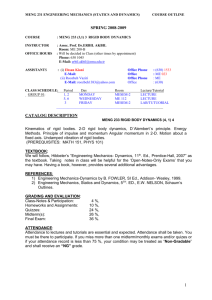Course Syllabus
advertisement
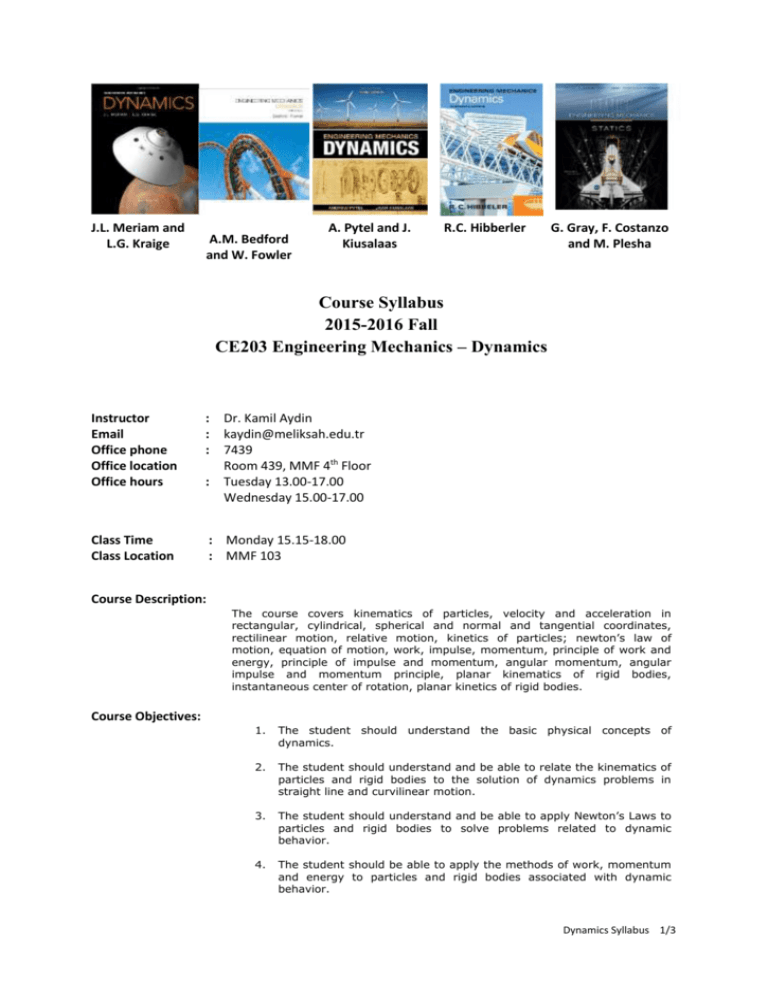
J.L. Meriam and L.G. Kraige A.M. Bedford and W. Fowler A. Pytel and J. Kiusalaas R.C. Hibberler G. Gray, F. Costanzo and M. Plesha Course Syllabus 2015-2016 Fall CE203 Engineering Mechanics – Dynamics Instructor Email Office phone Office location Office hours : : : Class Time Class Location : Monday 15.15-18.00 : MMF 103 : Dr. Kamil Aydin kaydin@meliksah.edu.tr 7439 Room 439, MMF 4th Floor Tuesday 13.00-17.00 Wednesday 15.00-17.00 Course Description: The course covers kinematics of particles, velocity and acceleration in rectangular, cylindrical, spherical and normal and tangential coordinates, rectilinear motion, relative motion, kinetics of particles; newton’s law of motion, equation of motion, work, impulse, momentum, principle of work and energy, principle of impulse and momentum, angular momentum, angular impulse and momentum principle, planar kinematics of rigid bodies, instantaneous center of rotation, planar kinetics of rigid bodies. Course Objectives: 1. The student should understand the basic physical concepts of dynamics. 2. The student should understand and be able to relate the kinematics of particles and rigid bodies to the solution of dynamics problems in straight line and curvilinear motion. 3. The student should understand and be able to apply Newton’s Laws to particles and rigid bodies to solve problems related to dynamic behavior. 4. The student should be able to apply the methods of work, momentum and energy to particles and rigid bodies associated with dynamic behavior. Dynamics Syllabus 1/3 Group Work: Copying of assignments is prohibited. However, I encourage you to work alongside each other as you work on homework assignments. The interaction of teaching and learning within a group setting is a great way to learn the principles taught in class. Of course, exams are a purely individual responsibility. Textbook: J.L. Meriam, L.G. Kraige, 2013, Engineering Mechanics-Dynamics, (7th Edition) SI Version, Wiley. Calculators: Only FE permitted calculators will be allowed for use on Exams. No cell phones, laptops, or any other electronic devise may be used. Course Grading: The grading breakdown is as follows: Homework 25% Midterm Exam 35% Final Exam 40% Anyone scoring under 50% in weighted average of midterm, HW and final cannot have a passing grade. (that is, 0.25*Homework + 0.35*Midterm+0.40*Final = 50 at least) Reading Assignments: Reading assignments will be assigned to complement lectures. Ideally, the assigned material should be studied prior to the corresponding lecture. You are responsible for the assigned readings besides the content that is presented during lectures Makeup exam policy: For students who cannot attend midterm exam due to university business duty, serious illness, or family emergency (all with written proof), a makeup exam may be arranged AFTER the regular exam. The instructor must be notified prior to the exam, and no exceptions will be made without a legitimate reason and a timely arrangement. Attendance: According to the university regulations, students must attend at least 70 % of the lecture hours. Otherwise, the student gets NA (Not attended) from the course. Valid excuses are exempt from computation of these percentages. Dynamics Syllabus 2/3 Course Outline: Chapter 1. Kinematics of Particles 1.1. Rectilinear Kinematics 1.2. General Curvilinear Motion 1.2.1. Rectangular Components 1.2.2. Cylindrical Components 1.2.3. Normal and Tangential Components 1.3. Constrained Motion of Connected Particles 1.4. Relative-Motion Analysis Using Translating Axes Chapter 2. Kinetics of Particles: Force, Mass, and Acceleration 2.1. Rectilinear Motion 2.2. Curvilinear Motion Chapter 3. Kinetics of Particles: Work and Energy 3.1. Work of a Force 3.2. Principle of Work and Energy 3.3. Principle of Work and Energy for a System of Particles 3.4. Conservative Forces and Potential Energy 3.5. Conservation of Energy Theorem Chapter 4. Kinetics of Particles: Impulse and Momentum 4.1. Principle of Impulse and Momentum 4.2. Principle of Impulse and Momentum for a System of Particles 4.3. Conservation of Linear Momentum for a System of Particles 4.4. Impact Chapter 5. Plane Kinematics of Rigid Bodies 5.1. Rigid-body Motion 5.1.1. Translation 5.1.2. Rotation 5.1.3. General Plane Motion 5.2. Relative Motion Analysis: Velocity 5.3. Instantaneous Center of Zero Velocity 5.4. Relative Motion Analysis: Acceleration Chapter 6. Planar Kinetics of Rigid Bodies: Force and Acceleration 6.1. Mass Moments of Inertia Dynamics Syllabus 3/3
